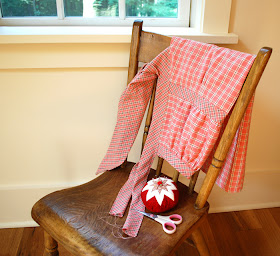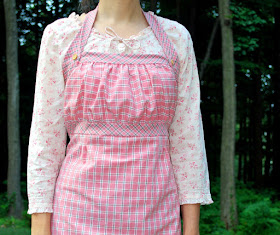A White Robin
The Lady-of-the-House sipped a green smoothie for breakfast. She stood staring out the French doors of her kitchen/keeping room, rather than exiting them. It was hazy and already hot at 8 o’clock in the morning. It would be another 100F degree-day in July. The public was urged to stay indoors due to dangerous air quality. She stood mesmerized and motionless watching a flock of robins eating their breakfast on the lawn.
She was contemplating what to do with the pumpkin zucchinis (her word for them) that she had been harvesting from one prolific plant - trying to remember what had come over her to buy the seedling in the first place; novelty she supposed. I’ll carve out the seeds, fill them with seasoned brown rice and bake them, she mused.
First I want to work on that apron I started months ago. It’s been a work-in-progress too long, she sighed. What a time she had with it over the summer. It is a fussy pattern. She almost made a mess of it by taking it in three inches on both sides of the bodice. She questioned why she trusted claims of one-size-fits-all while she sewed buttons (as camouflage) over the places where she had made adjustments indelicately. She took a break and laid it over a chair for another day.
Having finished the last bite of his toast, the son of the Lady-of-the-House noticed her staring out the French doors. He stepped up beside her. “Mom, what are all those spotted birds?”
“Teen-age robins,” she answered. “They still wear the speckled breast of fledgling days but are almost as large as the adults.” This satisfied him and he left the room to start his day at the computer.
 That is when she spotted it - a white robin - not snow white but a creamy blonde. It had an orange breast but the rest of it was blonde – beak and all. She was excited.
That is when she spotted it - a white robin - not snow white but a creamy blonde. It had an orange breast but the rest of it was blonde – beak and all. She was excited.
“Get the camera,” she called out. "It's a white robin." His office being in earshot, these words sent the Man-of-the-House jettisoning into the kitchen with camera in hand.
“Where?”
“There,” she pointed.
“Why isn’t the camera beeping?” he said. He then realized that it was set on manual focus. “I’ll be right back.”
“Where are you going?” his wife spoke to his back – in a tone of anxiety.
“To get the telephoto lens.”
When he returned the bird, by that time, had left the feeding ground and had fluttered onto a branch. “I see it,” said the Man-of-the-House twisting his large lens in place. Then he dashed outside. One shot (blurry) was taken from a distance in the nick of time before it flew further into the woods.
“I can’t believe I saw a white robin,” said the Lady-of-the-House. I guess they're on my mind. You did just order that copy of The White Robin for me a few nights ago. The coincidence is uncanny.” She was preparing a post to recommend the stories by Miss Read – delightful stories in which she occasionally indulges. This gave her the idea to add a few more novels to her collection.
That afternoon the book order arrived. The White Robin was in the parcel. “I can’t believe it,” she said again.
“You should tell your blog friends,” suggested the Man-of-the-House.
“I will.”
Albino robins or red-breasted blonde robins aren’t as rare, perhaps, as people suppose. One only has to do some lingering to look. A few days hence the Lady-of-the-House had another visitation of the blonde robin. It landed in view while she was at the kitchen sink washing dishes. She began calling it her robin. Within the week her new-used library discard of The White Robin was read and enjoyed. Truth can be as strange as fiction, she pondered as she closed the book – twisting a line from Shakespeare.
She was also happy to have finished her apron.
The White Robin (out-of-print) begins with a child of the village school spotting an unusual white bird on a hot day in July. It is part of the Fairacre series. Village School begins the series. Here we meet, Miss Read, the main character of most of the Fairacre novels. She is hired as the headmistress of the two-room village school and proves a dedicated teacher. She enjoys her quiet single-hood when off duty but also takes part in village festivities.
Nothing too dramatic happens in Fairacre. In fact it might be said that there is less conflict in Fairacre than may exist in our own face-paced lives. Many find it soothing to read about the routines of a long-established way of life in an English village where people walk to shops, greet passers by, pop in for chats and sips of tea. Simple folk with good manners (most of them) live their tidy British lives among stone churches, train stations, hedgerows, thatched houses and back gardens lined with ancient perennial flowerbeds. Beyond the village is the tranquil countryside where Miss Read leads her children on nature walks whenever it fancies, whenever the weather is ideal for it.
Inside any copy of a Fairacre novel is a handy list of other books in the series. All the stories make for the kind of light easy reading so appreciated at the end of a particularly tiring day.
A favorite of the Lady-of-the-House is Miss Clare Remembers (out-of-print). In the early part of the 20th century Miss Clare is a little girl who lives in a white cottage that her father freshly thatches. When a young woman she looses the young man she loves in the First World War. Miss Clare teaches the youngest students of Fairacre's village school without a college degree but with some training. Her firm-but-kind methods are carried out in a lady-like demeanor to her credit.
Mrs. Pringle of Fairacre was chosen as a read-aloud after Village School to share with a grown daughter. It is a good example of how to get along graciously (and with sympathy and a sense of humor) with those one or two people God may put into our lives who are “prickly.”
The Man-of-the House voiced his liking of the new apron. Therefore, the Lady-of-the-House is saving it for “best.” She cannot bear the thought of finding a splash of spaghetti sauce on it – not until she makes another one – from another pattern – with less fuss. For now, it rests on the drying rack of the kitchen/keeping room.
Post Script
If you have a copy of Edith Holden’s The Country Diary of an Edwardian Lady, you may be interested in page seven. In her January 26th 1906 entry she talks about a “curious robin” . . . that “when it is flying it looks like a white bird with a scarlet breast.”
Hasn’t Baby gotten roly-poly?
Indoors, lingering at windows, lingering with book friends, anticipating a visit from grandsons,
Karen Andreola

























